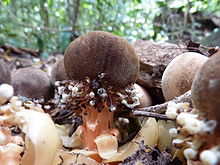Balanophora fungosa
| Balanophora fungosa | |
|---|---|
 |
|
| B. fungosa growing in rainforest near Kuranda in Far North Queensland. | |
| Scientific classification | |
| Kingdom: | Plantae |
| Clade: | Angiosperms |
| Clade: | Eudicots |
| Order: | Santalales |
| Family: | Balanophoraceae |
| Genus: | Balanophora |
| Species: | B. fungosa |
| Binomial name | |
|
Balanophora fungosa J.R.Forst. & G.Forst. |
|
Balanophora fungosa, sometimes known as fungus root is a flowering plant in the family Balanophoraceae and occurs in South Asia, Southeast Asia, Australia and some Pacific Islands. It is an obligate parasite growing on the roots of rainforest trees. The flowering structure is shaped like a puffball but in fact consists of a globe covered with thousands of tiny female flowers. The globe is surrounded at its base by a much smaller number of male flowers. In flower, the plant emits an odour resembling that of mice.
Like other members of its genus, B. fungosa is holoparasitic and contains no chlorophyll. The aerial parts of the plant consist of a hard, irregularly shaped tuber from which the flower-bearing structures extend. The leaves are scale-like, pale cream in colour, 8–30 millimetres (0.3–1 in) long, 7–20 millimetres (0.3–0.8 in) wide and more or less stem clasping.
The plant is monoecious, bearing both pistillate (female) and staminate (male) flowers. Thousands of minute female flowers cover a globe-shaped structure 15–20 millimetres (0.6–0.8 in) in diameter. The styles are less than 1 millimetre (0.04 in) long. About 20 male flowers are arranged around the base of the globe, each about 3–5 millimetres (0.1–0.2 in) in diameter with a pedicel about 5–6 millimetres (0.20–0.24 in) and are covered with powdery white pollen.
Balanophora fungosa was described by Johann Reinhold Forster and Georg Forster in 1774 and the description was published in Characteres Generum Plantarum. The specific epithet (fungosa) is a Latin word meaning "full of holes" or "spongy".
...
Wikipedia
